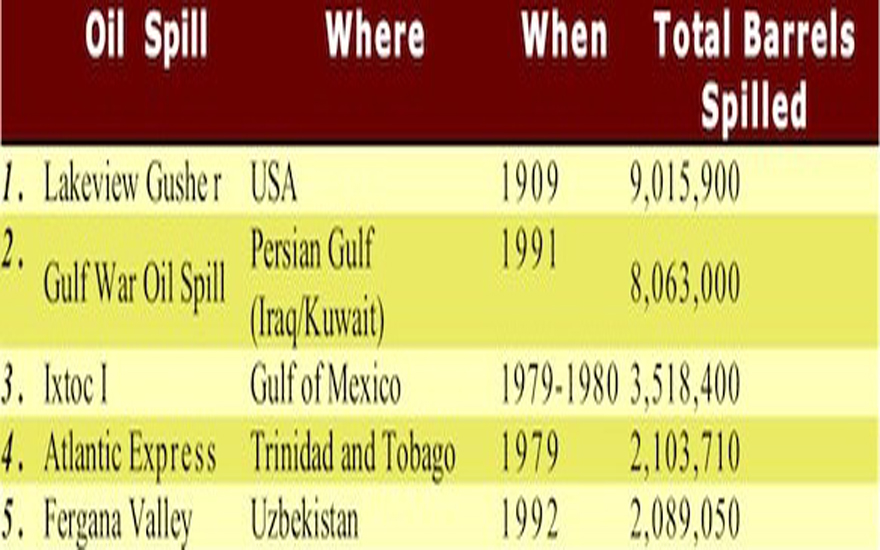With Time the Spill Rate of BP Oil Disaster Only Gets Worse
It is day 53 of the Deepwater Horizon oil spill.
And US government estimates of the amount of oil spilled into the Gulf of Mexico rose again recently.
Ever since the explosion that killed 11 platform workers on April 20 and sunk the now infamous oil rig, there has been debate about how much oil has been gushing into the Gulf of Mexico. Energy company BP has implemented various plans in an attempt to control the oil flow, but nothing has yielded good results. Even the effectiveness of the cap containment system implemented in early June has been questioned despite claims that it has been capturing as much as 15,000 barrels a day — some critics say much more is spilling out.
Here is what different groups have been saying about the spill rate over the past nearly two months:
April 20-24: Within days of the explosion, BP officials and the US coast guard estimated the spill rate to be about 1,000 barrels a day.
April 28: The US coast guard revises estimates and says 5,000 barrels a day spilling into Gulf.
April 29: The Natural Resources Defense Council quotes an independent scientist who (based on aerial images and BP measurements of oil layer thickness on the water surface) says the spill rate is about 20,000 barrels a day.
May 14: NPR in the US reports that it requested experts to examine BP-released video of the oil leak in a bid to get estimates of the spill rate. NPR said:
“BP has said repeatedly that there is no reliable way to measure the oil spill in the Gulf of Mexico by looking at the oil gushing out of the pipe. But scientists say there are actually many proven techniques for doing just that.”
Here is what they estimated:
Steven Wereley, an associate professor of mechanical engineering at Purdue University, using a technique called particle image velocimetry, calculated the spill rate to be 70,000 barrels a day (but says the number could be between 56,000 and 84,000).
Eugene Chiang, a professor of astrophysics at the University of California, Berkeley, came up with a bigger range for the potential spill rate: around 20,000 to 100,000 barrels per day.
May 27: The Flow Rate Technical Group (FRTG), an independent group of experts tasked to assess the spill and advise the US government, says the spill rate is between 12,000 to 19,000 barrels per day.
June 10: The FRTG revises estimates and states that as many as 40,000 barrels of oil per day may have been spilling out from the burst well since before the cap was put on the well on June 3.
There has been much debate over the methodologies used to estimate the spill. But even BP, according to theNew York Times, admitted its take on the worst-case scenario is indeed ugly:
“BP later acknowledged to Congress that the worst case, if the leak accelerated, would be 60,000 barrels a day, a flow rate that would dump a plume the size of the Exxon Valdez spill into the gulf every four days. BP’s chief executive, Tony Hayward, has estimated that the reservoir tapped by the out-of-control well holds at least 50 million barrels of oil.”
Fifty million barrels. The biggest oil spill in history was just over 9 million barrels. So, in the unlikely case that this gusher is not controlled, this spill could be 5.5 times as bad.
Using the FRTG’s estimate of 40,000 barrels per day, after 53 days the amount of oil spilled from the well would be 2,120,000 barrels (this would be considered an official top end amount with some of that that oil being captured by the cap system now in place: maybe slightly more than 150,000 barrels captured over 10 days). Already, at the minimum, the spill is more than four times as bad as that of the Exxon Valdez in 1989, which was until this year the worse spill in US waters, dumping 250,000 barrels into Prince William Sound in Alaska.
If the gusher is not stopped, at a spill rate of 40,000 barrels a day, a 50 million-barrel reservoir would take 1,250 days to empty. That is three years and 154 days (including one leap year). Mind you, experts are not claiming that all 50 million barrels will leak into the sea. Relief wells are being dug that should enable BP to stop the flow of oil. The company estimates that they will have these wells completed and operational by August.
But by then, over 3 million barrels of oil will likely have spilled into the sea and BP’s Deepwater Horizon oil spill will be in the running for being one of the top three worst oil spills of all time.
The Top Five Largest Oil Spills in History Before The Deepwater Horizon Disaster (and the Exxon Valdez is not one of them)

The largest oil spills in history: The Exxon Valdez, while a devastating disaster, is far down the list of biggest oil spills with 250,000 barrels of oil lost at sea. Source: wikipedia.com; numbers are approximate and based on 7.33 barrels of oil being equivalent to one tonne of crude.



